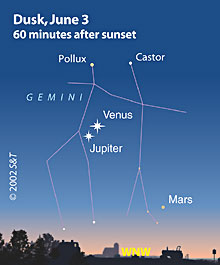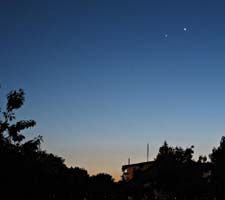
Venus and Jupiter continue to put on a show in the west after sunset. This twilight view is drawn for an observer near the middle of North America, but it's reasonably accurate for skywatchers all across the continent.
Sky & Telescope diagram.
Although there are no longer five planets visible in the west after sunset, the two brightest naked-eye worlds — Venus and Jupiter — continue to put on quite a show. Choose the description for your date. The descriptions are good for viewers in the United States, southern Canada, and western Europe. In general, those in Asia will see specific arrangements one day earlier than as given here.
June 1–2: Dazzling Venus and not-as-bright Jupiter create a head-turning spectacle in the western sky after sunset. Above them are the much fainter stars Pollux and Castor.
June 3: This evening Venus and Jupiter, the two brightest planets, have an eye-catching conjunction in the western sky at dusk.

Venus (right) and Jupiter were dazzling in the western sky at dusk on June 2, 2002, one night before their closest approach. This view was recorded from Summit Park in Brookline, Massachusetts, with a digital camera.
S&T photo by Rick Fienberg.
They're separated by less than the width of a finger held at arm's length, yet they're at very different distances from us. Venus is 11 light-minutes (119 million miles) from Earth this evening, while Jupiter is almost five times farther at 50 light-minutes (561 million miles). Above them shine the much fainter stars Pollux and Castor, distant by 34 and 52 light-years, respectively (200 trillion and 305 trillion miles).
June 4–8: Venus and Jupiter are still appear strikingly close together, but the gap between them widens daily. By late June, Jupiter will be disappearing down into the glow of sunset, while Venus will remain in bright view.
 0
0
Comments
You must be logged in to post a comment.